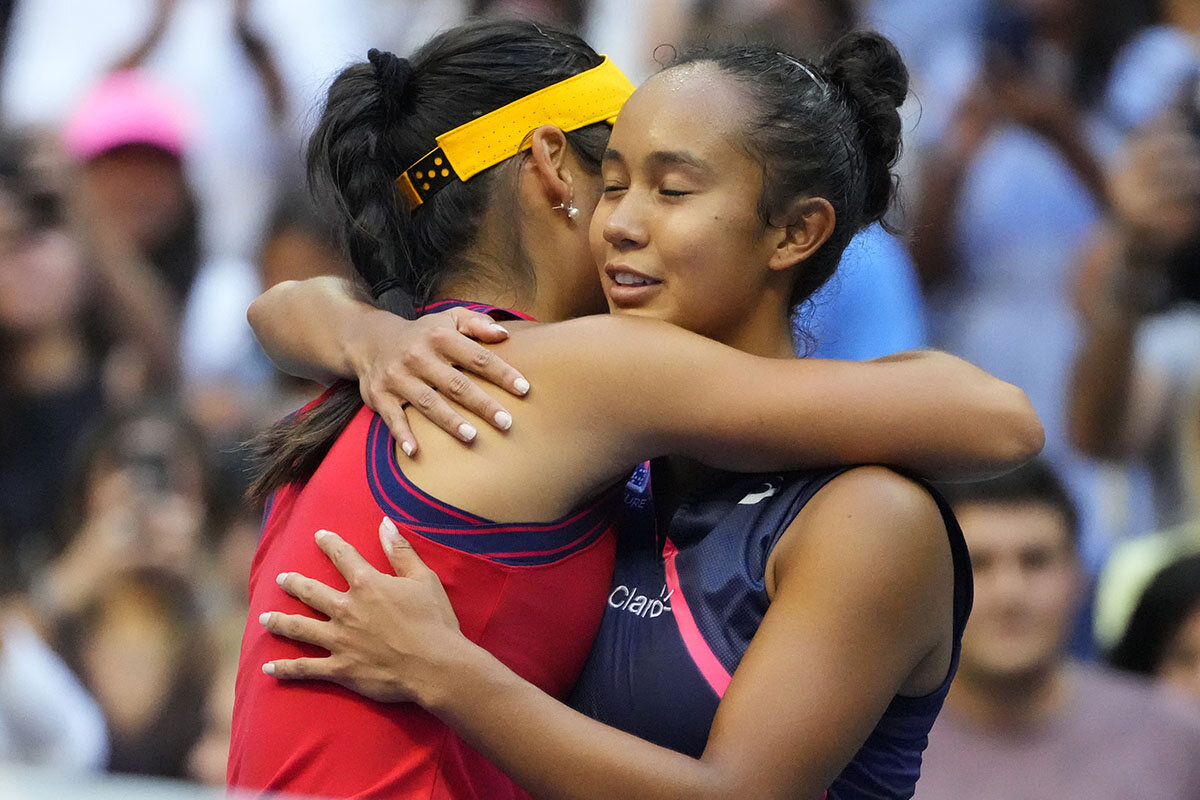Advantage joy: Teenage US Open tennis champ vs. world’s woes
Loading...
| London
The pandemic. Afghanistan. Superpower tensions. America’s bitter partisanship ...
All of it – for at least a few hours last weekend – was pushed aside by an uplifting sense of wonder and joy, which, even in today’s world, demonstrated the power to unite.
That a sports event provided this catalyst may not be that surprising. Back in the 1960s, no less a figure than Earl Warren, chief justice of the U.S. Supreme Court, quipped that he liked to read his morning newspaper from back to front. “I turn to the sports pages first,” he said. “They record people’s accomplishments. The front page has nothing but man’s failures.”
Why We Wrote This
Sports events can sometimes lift us out of ourselves. Emma Raducanu won the U.S. Open tennis tournament with a display of wonder and joy that showed sport’s power to unite.
Still, this particular sporting contest – the women’s final at the U.S. Open tennis tournament – carried a special potency, reaching beyond mere tennis fans and national borders.
Why? Largely because of the almost ridiculously unlikely finalists. Both teenagers, ranked well outside the top tier. Both from richly varied ethnic backgrounds. Both bringing a mix of self-confidence, determination – and, yes, joy – to their sudden emergence on the sport’s largest stage.
On one side of the net, Canadian Leylah Fernandez, who’d turned 19 just days earlier. She’s the daughter of an Ecuadorian father and a Filipina mother. On the pro tour for just a couple of years, she was ranked outside the world’s top 70 players when the Open began.
On the other, Britain’s Emma Raducanu, a mere 18; her father, Romanian, her mother Chinese. Her route to the final – which she won in front of more than 20,000 rapt and screaming fans – was even more improbable.
Before her major tennis debut last summer, courtesy of a wild-card invitation to Wimbledon, her world ranking was 338. Though she had nominally turned professional, her focus this summer was on her “A Levels,” the British equivalent of SATs, in her two favorite subjects, math and economics.
Any thought of joining the world tennis tour was scotched by the pandemic. Her parents insisted this was no time to be traveling the globe.
So she first drew real attention at this summer’s Wimbledon. She had an unlikely run there as well: She reached the fourth round, a step away from the quarterfinals. Yet she had to retire with breathing difficulties. In her words, the unfamiliar spate of success had “caught up” with her.
Fast-forward to the U.S. Open this past weekend. With some in Britain’s media suggesting her Wimbledon exit had meant she lacked the “toughness” to rise further, she had pocketed her A Level results – an A-plus in math, an A in econ – and, last month, set out for America to compete in lower-level events. The aim was to raise her ranking sufficiently to get into the three-match qualifying process for entry into the U.S. Open.
By the time of Saturday’s final, much of the tennis world, and huge numbers of new fans in the wider world, were riveted. She’d made it through her three qualifiers, and six main-draw matches against increasingly experienced and high-ranked players, without dropping a set.
And she’d crowned each match with an incandescent smile that seemed to contain equal measures of pleasure and disbelief.
When she won the final, the response from the tennis cognoscenti was pure awe. She was the first player to have gone all the way from the qualifying rounds of a major tournament to the final, let alone to win it.
But it was the wider reaction that offered such a powerful contrast to the news diet of concern, conflict, and division that has become familiar in today’s world.
There was a worldwide outbreak of celebration, lavished on both Cinderella finalists. Canadians were especially well placed to embrace both: Ms. Raducanu was born in Canada; her parents moved to Britain when she was 2.
She has always embraced her varied roots. Her Instagram profile reads: London/Toronto/Bucharest/Shenyang. By the time of the final, she had built up some 600,000 followers. Now, she has 1.7 million, and rising.
Amid a torrent of interviews long into Saturday night, she recorded a thank-you message – in Mandarin – for supporters in China. “She speaks just like a Dong Bei girl,” gushed one fan on China’s Weibo network, referring to the ancestral home of Ms. Raducanu’s mother.
In Britain, sporting figures, politicians, even the queen celebrated her feat. But more than that, they celebrated the feelings that the final inspired.
“What a glorious day for two remarkable young women,” wrote British actor and author Stephen Fry. “Yes, it may be ‘only’ sport, but in that ‘only’ there can be found so much of human joy, despair, glory, disappointment, wonder and hope.”
“We’ve witnessed such heaviness and pressure in the last year,” added American tennis great Chris Evert. “These girls brought joy.”
The most eloquent postscript came from another former star, the Slovakian Daniela Hantuchova. Enlisted as an analyst by Amazon Prime for its coverage, she’d followed Ms. Raducanu’s march to the final, round by round.
Her abiding memory, she said, was “the smile. ... That smile comes from the heart. It’s pure. It’s real.” Her wish for Ms. Raducanu was that she manage to keep that smile.
And, she might well have added, that the rest of us manage to keep ours as well.







